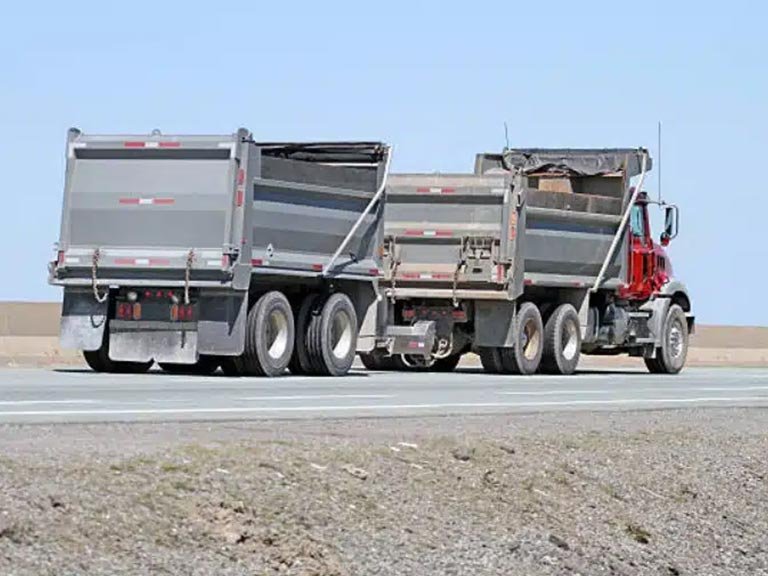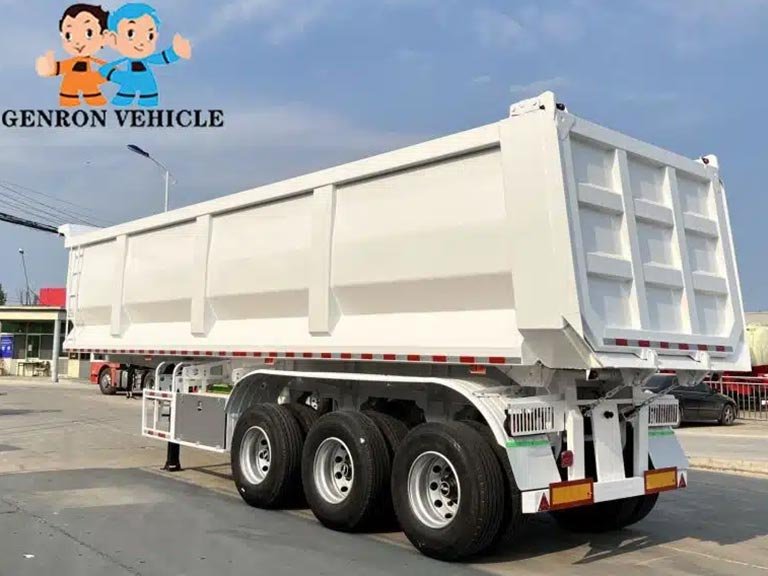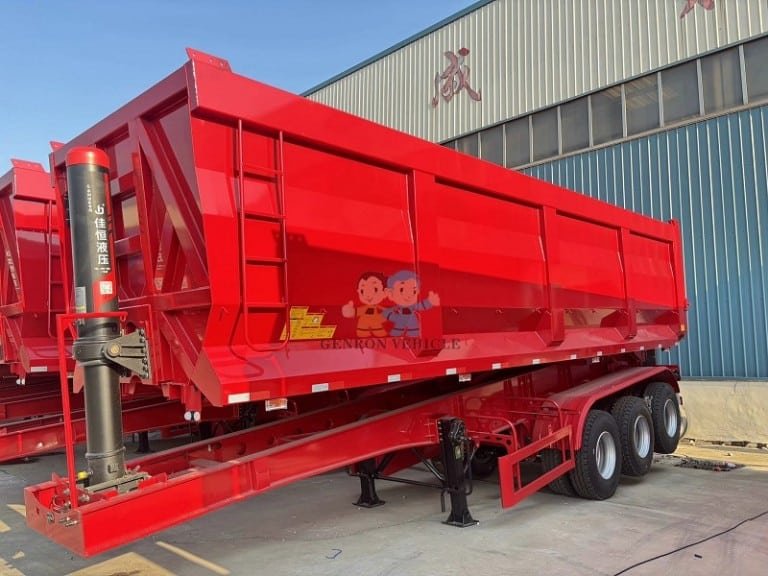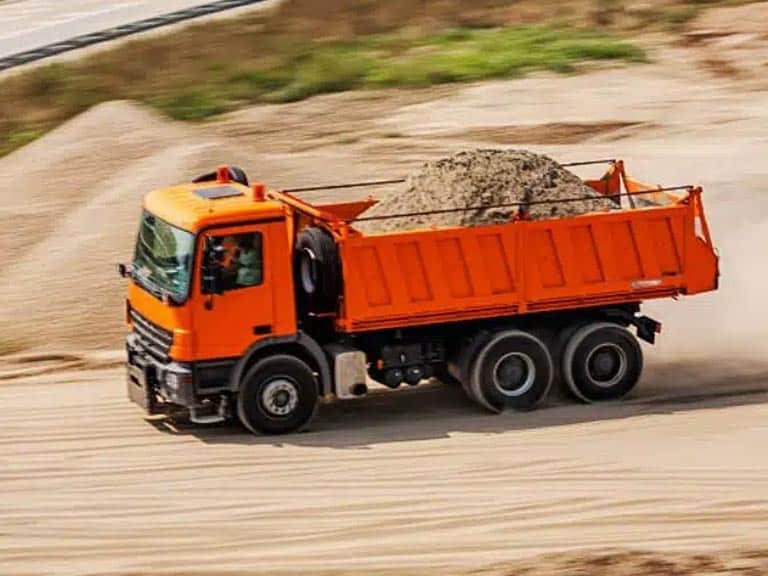Genron International Trade is dedicated to providing high-quality end dump trailers to meet various industry transportation needs. Properly loading an end dump is crucial for ensuring safe, efficient, and stable transportation. This article details how to load an end dump trailer, covering preparation, loading steps, and safety measures.
Table of Contents
Preparation
- Inspect the Trailer: Before loading, ensure the trailer is in good condition. Check tire pressure, the hydraulic system, and the trailer bed for any damage. Repair any damage or leaks immediately, especially in the hydraulic system, ensuring normal hydraulic oil levels and no leaks.
- Choose the Right Location: Select flat, solid ground for loading to prevent the trailer from moving or tilting during the process. The stability of the ground directly affects loading safety and efficiency.
- Wear Safety Gear: Ensure operators wear appropriate personal protective equipment (PPE), such as hard hats, gloves, and steel-toed boots, to prevent accidents. Ensure all operators are familiar with emergency procedures.
- Prepare Loading Equipment: Prepare loading equipment, such as forklifts or conveyors, ensuring they are in good working condition and meet safety standards. Check all parts of the loading equipment for wear or malfunction.
Begin with a bespoke semi-trailer designed for your exact needs. Whether it’s heavy-duty hauling or specialized cargo, we’ve got the perfect solution to keep you moving forward.
Safety Measures
- Continuous Monitoring: Continuously monitor the trailer and loading equipment during loading to ensure smooth operation and handle any issues promptly. Operators should stay alert to potential safety hazards.
- Prevent Overloading: Strictly adhere to the trailer’s rated load limit to prevent overloading, which can damage the trailer and increase the risk of tipping and accidents. Use appropriate weighing equipment to ensure the load is within safe limits.
- Use Warning Signs: Set up warning signs around the loading area to keep others away from the operation area, preventing accidents. Ensure the loading area is well-lit to improve visibility and safety.
- Emergency Preparedness: Prepare emergency plans to handle any emergencies during loading, such as equipment failure or material spillage. Ensure all operators are familiar with emergency procedures and can respond quickly.
Loading Steps
- Position the Trailer: Accurately park the trailer in the loading position, aligning it with the loading equipment. Use the hand brake and wheel chocks to secure the trailer, preventing movement. Ensure the trailer is level to avoid tilting during loading.
- Start Loading: Start the loading equipment and slowly load materials into the trailer. Ensure the materials are evenly distributed to avoid imbalance. Layer the materials to ensure even loading.
- Check Weight Distribution: Regularly check weight distribution during loading to ensure the load is evenly spread. Avoid overloading one side or the center to prevent tipping. Use weight distribution detection equipment if necessary.
- Control Loading Speed: Control the loading speed to avoid overloading the trailer or causing damage. Increase the load gradually to ensure safety. Operate the loading equipment smoothly without causing strong vibrations.
- Final Adjustments: After loading, make final adjustments to ensure all materials are evenly distributed and do not exceed the trailer edges. Check that the tailgate is securely closed to prevent material spillage during transport. Ensure all securing devices are correctly installed and locked.

Methods for Loading Different Materials
Loading various materials into an end dump trailer requires a deep understanding of the characteristics of each material. Tail-unloading trailers typically transport materials such as sand, gravel, crushed stone, and asphalt. Due to their sturdy construction, wear and tear on the trailer’s side walls, floor, and other surfaces is relatively minimal.
- Aggregates and Gravel: Aggregates and gravel are among the most common materials transported using end dump trailers. When loading these materials, it’s essential to follow a pyramid pattern, concentrating the material in the center of the trailer. This approach prevents shifting during transport and facilitates easier unloading.
- Loading Sand and Fine Materials: Sand and fine materials require special attention. Because they can shift dramatically during transport. To mitigate this, we recommend loading these materials evenly across the trailer. In cold weather, consider using anti-freeze agents to prevent freezing.
- Heavy or Abrasive Materials: Heavy materials such as debris or broken concrete should be loaded with caution. This is to avoid concentrating weight on a single point, which could put pressure on the trailer structure. Abrasive materials, on the other hand, can cause premature wear to the trailer bed and tailgate. Using protective liners or coatings can help mitigate this issue when regularly hauling such materials.
Preventing Load Freezing and Sticking
Preventing load freezing and sticking is a critical aspect of safely transporting materials with an end dump trailer. We need to consider various factors to ensure that our materials arrive at their destination in the desired condition.
- Weather Considerations: One of the primary factors to consider is the weather along your entire route. It’s not enough to just check the weather at your loading point. You must also consider the conditions at your destination and any potential stops along the way.
- Anti-Freezing Agents: To prevent load freezing, we can use anti-freezing agents like salt. Typically, 10-12 pounds of salt per load is sufficient to prevent material freezing during winter transport. However, it’s crucial to obtain customer approval before adding any anti-freezing agents. Because some receiving facilities have strict policies against certain additives.

Post-Loading Check
- Check Securing: Ensure all materials are securely fastened with appropriate straps or chains to prevent movement during transport. Securing devices should withstand the material’s weight and vibrations during transport.
- Inspect the Hydraulic System: Check the hydraulic system to ensure no leaks and that everything is functioning properly. The hydraulic system’s proper operation is crucial for safe unloading.
- Confirm Load Safety: Perform a final check to confirm the load is secure, there are no overloads, and all equipment and tools are properly stored. Ensure all doors and hatches are securely closed.
- Record Loading Information: Record loading information, including load weight, material type, and loading time, as part of the transportation record. Detailed records help track the transport process and provide references for future loading.
Safe Unloading Procedures
The process of unloading an end dump trailer involves several key steps that must be followed for optimal safety. Unloading is a critical stage that requires careful planning and execution. This helps prevent accidents and ensures the longevity of the trailer.
- Assessing the Dump Site: Before beginning the unloading process, it’s crucial to assess the dump site for potential hazards. This includes checking for overhead power lines, soft ground, or uneven surfaces that could compromise trailer stability. A thorough assessment helps in identifying risks and taking necessary precautions.
- Proper Positioning for Unloading: Positioning the trailer correctly is vital for safe unloading. The trailer should be placed on the most level ground available, avoiding side slopes that could increase the risk of tip-overs. When raising the trailer, it should be done gradually while monitoring for signs of instability.
- Preventing Trailer Tip-Overs: To prevent the trailer from tipping over, never drive with the dump body raised. In addition, exercise caution when unloading in windy conditions. If material begins to stick or bridge during unloading, lower the body slightly, pull forward a short distance, and then continue raising the body.

Common Issues and Solutions
- Material Spillage: If materials spill during loading, stop loading immediately, clean up the spillage, and adjust the loading method to ensure even distribution. Check if it is necessary to replace or reinforce the loading equipment.
- Equipment Failure: If the loading equipment fails, stop the operation and check the issue. Repair or replace the equipment as needed to ensure safe loading. Regularly maintain the equipment to reduce the likelihood of failure.
- Uneven Load: If the load is uneven, stop loading and redistribute the materials. Use forklifts or other tools to reposition the materials and ensure balanced loading. Use weighing equipment to check load distribution accurately.
- Hydraulic System Issues: If the hydraulic system has problems, such as the hydraulic cylinder not lifting properly, check the hydraulic oil level and system components. Repair or replace as needed. Regularly maintain the hydraulic system to keep it in good condition.
Post-Loading Considerations
- Safe Transport: After loading, ensure safe transport. Avoid sharp turns and sudden stops, and drive smoothly to minimize load movement. Slow down on curves and slopes.
- Regular Checks: Regularly check the trailer and load during transport to ensure everything is normal. If any issues arise, stop and check immediately. Regular checks include tires, the hydraulic system, and securing devices.
- Unload Preparation: Upon arrival at the destination, prepare unloading equipment and ensure the unloading area is safe. Carefully unload materials in reverse order, ensuring safe operation. Gradually release securing devices to prevent sudden material movement.
- Maintenance Records: Record the maintenance status of the trailer and equipment after each transport and loading to facilitate regular maintenance and checks, extending equipment life. Detailed maintenance records help identify potential issues and take timely action.

Conclusion
Properly loading an end dump trailer is crucial for safe and efficient transportation. By strictly following preparation, loading steps, and safety measures, you can maximize operational efficiency and reduce the risk of accidents. At Genron International Trade, we offer comprehensive end-dump trailer solutions to meet your transportation needs. Our professional team is ready to provide support and ensure your trailers are always in optimal condition. If you need professional assistance with end dump trailers, please contact our team for expert help.
FAQ
How can I ensure the safe loading of an end dump trailer?
Ensure safe loading by selecting flat, solid ground for loading, ensuring even material distribution, and strictly adhering to the trailer’s rated load limit.
How do I prevent material spillage during loading?
Use appropriate loading equipment, control loading speed, ensure even material distribution, and set up warning signs around the loading area to prevent material spillage.
What should I do if the loading equipment fails?
If loading equipment fails, stop the operation and check the issue. Repair or replace the equipment as needed to ensure safe loading.
How do I handle uneven load issues?
If the load is uneven, stop loading and redistribute the materials. Use forklifts or other tools to reposition the materials and ensure balanced loading.
What should I do after the loading is complete?
Ensure safe transport, regularly check the trailer and load during transport, prepare for unloading at the destination, and record maintenance status after each transport and loading.


